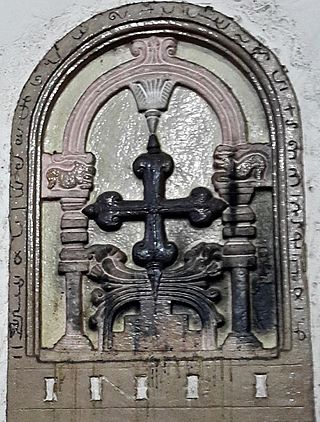
The Anuradhapura cross is a form of the Christian cross symbol. It is the most ancient symbol of Christianity in Sri Lanka. [1] [2] [3]

The Anuradhapura cross is a form of the Christian cross symbol. It is the most ancient symbol of Christianity in Sri Lanka. [1] [2] [3]
The cross was discovered in 1912 during archaeological excavations in Anuradhapura. [4] It is cut in sunk relief on the side of a smooth granite column of which a fragment was excavated. An immediate determination about the cross came from the Archaeological Commissioner of Ceylon, Edward R. Ayrton, who concluded that it was a Portuguese cross. In 1924, Ayrton's successor, Arthur Maurice Hocart, put more effort to clarify the cross and he described it in his publication, Memoirs of the Archaeological Survey of Ceylon, as being "a cross of a floret type standing on a stepped pedestal from which emanates two fronds on each side of the cross like horns". [4] Hocart also concluded it was a Portuguese cross. [1] [4] Both men considered that it was a Nestorian cross or "Persian Cross" from the Portuguese era. A number of historical records also suggest that Assyrian Church of the East may have been in Sri Lanka between the middle fifth and sixth centuries. [5] [6] [7] There, it is believed that the cross was dated to the Anuradhapura period. [8] Meanwhile, whilst it was considered as a Portuguese cross these claims are questionable given various historic facts, notably that the Portuguese did not have a presence in Anuradhapura at the time. [1]
The most conclusive determination of the cross's origins was made in 1926 by Humphrey Codrington, based on evidence contained in a 6th-century manuscript, Christian Topography , that a community of Persian Christians were known to reside in Taprobanê (the Ancient Greek name for Sri Lanka). Codrington wrote in his book, A Short History of Ceylon, that "about A.D. 500 we read of a Persian colony; a Nestorian cross undoubtedly belonging to this community is to be seen in the Anuradhapura museum". [9] [10] In 1954 the then assistant Archaeological Commissioner, Titus Devendra, dismissed the historical reliability of the Christian Topography and attributed the cross to the Portuguese dating it later than 1547. [11] Academics however have since concluded that the Christian Topography is historically accurate. [12] In 1984 an archaeological find at Manthai confirmed the existence of Persian Christians in Sri Lanka, including a seal with a Nestorian cross, with similar stylistic features to the Anuradhapura cross. [13]
The cross is considered as a variation of the St Thomas Cross [nb 1] due to its similar shape and possible links between the early Christian community in South India and Sri Lanka. The Anuradhapura cross however has unique features when compared to other crosses. [2] The three main elements that the Anuradhapura cross has in common with Nestorian crosses are: the "leaves" (with their upward facing fronds) at the base of the cross, which symbolize the "tree of life" (the vitality of the tree is accentuated by its fruit-like protrusions); the second element is that each of the arms of the cross terminate in a pearl. Pearls played a central theme in Syriac devotional literature and iconography. The third element is the base, which is a three-stepped pedestal. The three tiers symbolise the three levels of paradise, the three decks of the ark, and the three limits of ascent to Sinai. [15]
The Anuradhapura cross was featured in the official logo of Pope Francis' 2015 visit to Sri Lanka. The Roman Catholic Archdiocese of Colombo referred to the cross in this capacity as the Glorious Cross or the Cross of the Resurrection. [16]
The cross is also depicted on the coat of arms of the Diocese of Kurunegala of the Church of Ceylon. [17]
Nestorianism is a term used in Christian theology and Church history to refer to several mutually related but doctrinarily distinct sets of teachings. The first meaning of the term is related to the original teachings of Christian theologian Nestorius, who promoted specific doctrines in the fields of Christology and Mariology. The second meaning of the term is much wider, and relates to a set of later theological teachings, that were traditionally labeled as Nestorian, but differ from the teachings of Nestorius in origin, scope and terminology. The Oxford English Dictionary defines Nestorianism as:
"The doctrine of Nestorius, Patriarch of Constantinople, by which Christ is asserted to have had distinct human and divine persons."

Anuradhapura is a major city located in the north central plain of Sri Lanka. It is the capital city of North Central Province and the capital of Anuradhapura District. The city lies 205 kilometers (127 mi) north of the current capital of Colombo in the North Central Province, on the banks of the historic Malwathu Oya. The city is now a World Heritage Site famous for its well-preserved ruins of the ancient Sinhalese civilisation.

Sri Lanka is officially a Buddhist country, while Sri Lankans practice a variety of religions. As of the 2012 census, 70.2% of Sri Lankans were Buddhists, 12.6% were Hindus, 9.7% were Muslims, 7.4% were Christians. Buddhism is declared as the State religion of Sri Lanka and has been given special privileges in the Sri Lankan constitution such as the government is bound for protection and fostering of Buddhist Dharma throughout the nation. However, the constitution also provides for freedom of religion and right to equality among all its citizens. In 2008 Sri Lanka was the third most religious country in the world according to a Gallup poll, with 99% of Sri Lankans saying religion is an important part of their daily life.

The Catholic Church in Sri Lanka is part of the worldwide Catholic Church, under the spiritual leadership of the pope in Rome. The country comes under the province of Colombo and is made up of 12 dioceses including one archdiocese. There are approximately 1.2 million Catholics in Sri Lanka representing around 6.1% of the total population. Later estimates suggest that there are over 1.6 million in 2020.

Christianity is a minority religion in Sri Lanka. It was introduced to the island in first century. Traditionally, after Thomas the Apostle's visit in Kerala in AD 52, Christianity is said to have been introduced to Sri Lanka because of its close geographical and commercial ties.

The Roman Catholic Metropolitan Archdiocese of Colombo is a Latin metropolitan archdiocese of the Roman Catholic Church, whose ecclesiastical province covers all Sri Lanka plus the Maldives. It depends on the missionary Roman Congregation for the Evangelization of Peoples.

Mar Thoma Sleeva (Saint Thomas Cross) are ancient crosses associated with the community of Indian subcontinent, who trace their origins to the evangelism of Thomas the Apostle in the 1st century AD. The Saint Thomas Christians, which is one of the oldest Christian communities of the world, survive in the Malabar region in state of Kerala, India and have a diaspora in other parts of the Indian subcontinent. Saint Thomas Christian crosses are known as Mar Thoma Sleeva (Saint Thomas cross), Indian cross, or Persian Cross in English, as well as Nasrani Sthambam in Malabarese.

The current legislative capital of Sri Lanka is Sri Jayawardenepura Kotte and the executive and judicial capital is Colombo. Over the course of the island's history, the national capital has been in several locations other thanSri Jayawardenepura Kotte.

The Church of Ceylon is the Anglican Church in Sri Lanka. It is an extraprovincial jurisdiction of the Archbishop of Canterbury, who serves as its Metropolitan. It was established in 1845 with the appointment of the first Anglican Bishop of Colombo, James Chapman and until 1950 it consisted of a single diocese; in that year a second diocese was established at Kurunegala.
Mutasiva was ruler of the Kingdom of Anuradhapura in Sri Lanka, based at the ancient capital of Anuradhapura. He ruled from 367 BC to 307 BC. He had ten sons, some of whom were his successors such Devanampiya Tissa, Uttiya, Mahasiva, Suratissa and Asela. Mutasiva was the son of King Pandukabhaya.

The Kingdom of Tambapaṇṇī was the first Sinhalese kingdom in Sri Lanka. Its administrative centre was based at Tambapaṇṇī. It existed between 543 BC and 437 BC. According to the Mahavamsa, the Kingdom was founded by Prince Vijaya and his followers.
Upatissagāma was the second capital of the Kingdom of Tambapanni, during the Pre Anuradhapura period of Sri Lanka. It was seven or eight miles further north of the previous capital Tambapaṇṇī, which was in present-day Puttalam. The city was established by Upatissa, a follower and senior minister of Vijaya.

Mar Aprem Mooken is the Metropolitan of the Assyrian Church of the East in India.
Jettha Tissa II also known as Detutis II, was King of Anuradhapura in the 4th century, whose reign lasted 9 years from 332 to 341. He succeeded his brother Sirimeghavanna as King of Anuradhapura and was succeeded by his son Buddhadasa.
Aggabodhi V was King of Anuradhapura in the 8th century, whose reign lasted from 726 to 732. He succeeded his father Manavanna as King of Anuradhapura and was succeeded by his brother Kassapa III.

Cathedral of Christ the King is located on Kandy Road, Kurunegala, Sri Lanka. It is the primary Anglican cathedral of the Diocese of Kurunegala, affiliated to the Church of Ceylon.

The Department of Archaeology is a non-ministerial government department in Sri Lanka responsible for managing the archaeological heritage.

St. Thomas' Church is situated in Kotahena a suburb of Colombo, Sri Lanka. It is one of the oldest churches in Sri Lanka as now part of the Anglican Church of Ceylon.